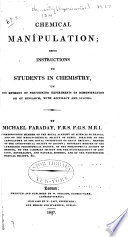 | William Phillips - 1816 - 222 páginas
...and bismuth arc two of the most fusible metals.. The fusible-metal of Sir Isaac Newton, is composed of 8 parts of bismuth, 5 of lead, and 3 of tin ; when this is thrown into water, and heat applied, it melts a little before the water has reached... | |
 | William Phillips, Samuel Latham Mitchill - 1818 - 364 páginas
...und bismuth are two of the most fusible metals. The fusible metal of Sir Isaac Newton, is composed of 8 parts of bismuth, 5 of lead, and 3 of tin; when this is thrown in* Native Bifmuth in brilliant plates, interfperfed through a'- rein of quartz,... | |
 | Thomas Hodgson (of Newcastle.) - 1820 - 224 páginas
...gives the following instructions for the preparation of this alloy : — The compound should be formed of 8 parts of bismuth, 5 of lead, and 3 of tin. Fuse the bismuth, cover it with resin or suet, and heat the whole rather strongly ; add the lead, stir... | |
 | William Phillips - 1823 - 558 páginas
...and bismuth are two of the most fusible metals. The fusible metal of Sir Isaac Newton, is composed of 8 parts of bismuth, 5 of lead, and 3 of tin ; when this is thrown into water and heat applied, it melts a little before the water has reached the... | |
 | 1824 - 884 páginas
...remarkable for their fusibility. With gold, platinum, and silver, it forms brittle compounds. A compound of 8 parts of bismuth, 5 of lead, and 3 of tin, liquifies at 212°; it is called fusible metal. The addition of 1 part of quicksilver renders it yet... | |
 | Michael Faraday - 1827 - 678 páginas
...242. For temperatures from 212° and upwards, fusible metal answers the purpose admirably. It consists of 8 parts of bismuth, 5 of lead, and 3 of tin, fused together. It melts at a beat below 212°, and will bear a red or even white heat without evolving... | |
 | Francis Lieber, Edward Wigglesworth, Thomas Gamaliel Bradford - 1830 - 650 páginas
...more equally effected by sand, or, what is still better, in hot oil, or fusible mixture, consisting of 8 parts of bismuth, 5 of lead and 3 of tin ; a thermometer being placed in the liquid at the time the razors are immersed, for the purpose of... | |
 | 1838 - 590 páginas
...remarkable fusibility. On this account it is much used for the composition of soft solders. A mixture of 8 parts of bismuth, 5 of lead, and 3 of tin, forms an alloy, which melts below the temperature at which water boils, and is known by the name of... | |
 | John White Webster - 1839 - 592 páginas
...greater than that of its components. Thus platinum, when alloyed with arsenic is very fusible, and an alloy of 8 parts of bismuth, 5 of lead, and 3 of tin liquefies at 212°. Oi¡d»tion 828. Alloys are generally more oxidizable than their constituents,... | |
 | 1842 - 476 páginas
...assumed the solid form. The alloy experimented on was that known as Newton's fusible metal, composed of 8 parts of bismuth, 5 of lead, and 3 of tin. On pouring this alloy, in the melted state, on a marble slab, and breaking it as soon as solid, and... | |
| |